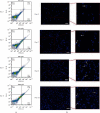Isolation and Characterization of Human Synovial Fluid-Derived Mesenchymal Stromal Cells from Popliteal Cyst
- PMID: 33014069
- PMCID: PMC7519976
- DOI: 10.1155/2020/7416493
Isolation and Characterization of Human Synovial Fluid-Derived Mesenchymal Stromal Cells from Popliteal Cyst
Abstract
Mesenchymal stem cells (MSCs) are multipotent progenitor cells in adult tissues. The aim of this study is to isolate and identify synovial fluid-derived mesenchymal stromal cells (SF-MSCs) from the popliteal cyst fluid of pediatric patients. SF-MSCs were collected from the popliteal cyst fluid of pediatric patients during cystectomy surgery. After cyst fluid extraction and adherent culturing, in vitro morphology, growth curve, and cell cycle were observed. The expression of stem cell surface markers was analyzed by flow cytometry, and expression of cell marker protein was detected by immunofluorescence. SF-MSCs were cultured in osteogenic, adipogenic, and chondrogenic differentiation medium. The differentiation potential of SF-MSCs was analyzed by alkaline phosphatase (Alizarin Red), Oil Red O, and Alcian blue. Antibody detection of human angiogenesis-related proteins was performed compared with bone marrow mesenchymal stem cells (BM-MSCs). The results show that SF-MSCs from the popliteal cyst fluid of pediatric patients showed a shuttle appearance and logarithmic growth. Flow cytometry analysis revealed that SF-MSCs were negative for hematopoietic lineage markers (CD34, CD45) and positive for MSC markers (CD44, CD73, CD90, and CD105). Interstitial cell marker (vimentin) and myofibroblast-like cell marker alpha-smooth muscle actin (α-SMA) were positive. These cells could differentiate into osteogenic, adipogenic, and chondrogenic lineages, respectively. Several types of human angiogenesis-related proteins were detected in the cell secretory fluid. These results show that we successfully obtained SF-MSCs from the popliteal cyst fluid of pediatric patients, which have the potential to be a valuable source of MSCs.
Copyright © 2020 Fang Li et al.
Conflict of interest statement
The authors declare no competing interests.
Figures









Similar articles
-
Isolation and characterization of multipotent mesenchymal stem cells in nasal polyps.Exp Biol Med (Maywood). 2015 Feb;240(2):185-93. doi: 10.1177/1535370214553898. Epub 2014 Oct 6. Exp Biol Med (Maywood). 2015. PMID: 25294891 Free PMC article. Clinical Trial.
-
Differentiation of synovial CD-105(+) human mesenchymal stem cells into chondrocyte-like cells through spheroid formation.J Cell Biochem. 2009 Sep 1;108(1):145-55. doi: 10.1002/jcb.22238. J Cell Biochem. 2009. PMID: 19544399
-
Comparative study of equine mesenchymal stem cells from healthy and injured synovial tissues: an in vitro assessment.Stem Cell Res Ther. 2016 Mar 5;7:35. doi: 10.1186/s13287-016-0294-3. Stem Cell Res Ther. 2016. PMID: 26944403 Free PMC article.
-
Mesenchymal stem cells: Cell therapy and regeneration potential.J Tissue Eng Regen Med. 2019 Sep;13(9):1738-1755. doi: 10.1002/term.2914. Epub 2019 Jul 25. J Tissue Eng Regen Med. 2019. PMID: 31216380 Review.
-
Isolation and in vitro characterization of bovine amniotic fluid derived stem cells at different trimesters of pregnancy.Stem Cell Rev Rep. 2014 Oct;10(5):712-24. doi: 10.1007/s12015-014-9525-0. Stem Cell Rev Rep. 2014. PMID: 24906426 Review.
Cited by
-
Body Fluid-Derived Stem Cells: Powering Innovative, Less-Invasive Cell Therapies.Int J Mol Sci. 2025 May 5;26(9):4382. doi: 10.3390/ijms26094382. Int J Mol Sci. 2025. PMID: 40362618 Free PMC article. Review.
-
Urine-derived stem cells in neurological diseases: current state-of-the-art and future directions.Front Mol Neurosci. 2023 Oct 30;16:1229728. doi: 10.3389/fnmol.2023.1229728. eCollection 2023. Front Mol Neurosci. 2023. PMID: 37965041 Free PMC article. Review.
-
Multilevel analysis of the central-peripheral-target organ pathway: contributing to recovery after peripheral nerve injury.Neural Regen Res. 2025 Oct 1;20(10):2807-2822. doi: 10.4103/NRR.NRR-D-24-00641. Epub 2024 Oct 22. Neural Regen Res. 2025. PMID: 39435615 Free PMC article.
-
Identification of FOXO1 as a geroprotector in human synovium through single-nucleus transcriptomic profiling.Protein Cell. 2024 May 28;15(6):441-459. doi: 10.1093/procel/pwad060. Protein Cell. 2024. PMID: 38092362 Free PMC article.
References
-
- Wakitani S., Mitsuoka T., Nakamura N., Toritsuka Y., Nakamura Y., Horibe S. Autologous bone marrow Stromal cell transplantation for repair of full-thickness articular cartilage defects in Human Patellae: two case reports. Cell Transplantation. 2017;13(5):595–600. doi: 10.3727/000000004783983747. - DOI - PubMed
LinkOut - more resources
Full Text Sources
Research Materials
Miscellaneous

